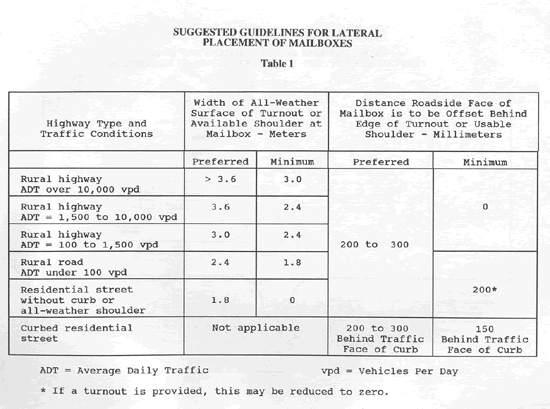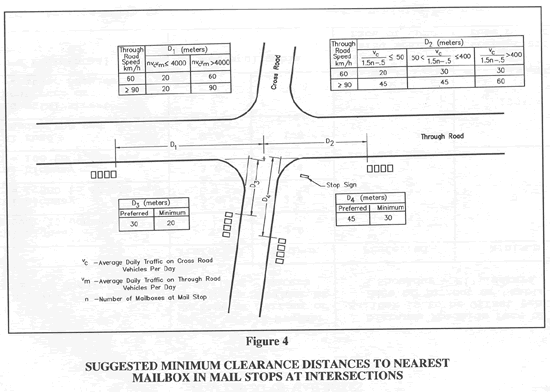Other Measures
60. Relocate Mailbox
Injury from striking a mailbox is not the only risk associated with mailboxes. The mail carrier's maneuvers in collecting and delivering mail and the patron's activities, as pedestrian or motorist, in depositing and collecting mail, create opportunities for traffic conflict and human error. Reducing the number and /or severity of these conflicts is an important objective of this guide.
It is only by banishing mailboxes from our highways that mailbox related traffic accidents could be eliminated. This is impractical, but to the extent there are identifiable and correctable problems, there is room for improvement. Through cooperation between the highway agencies, the U.S. Postal Service, and the postal patron, improvements in mailbox installation details and in may instances, locations can be effective with little or no increased cost to the public by simply seeing that good state-of-the-art practices are followed when mailboxes are installed or replaced. (A typical mailbox last from 5 to 20 years, depending on service conditions, with the average life being about 10 years. Traditionally, the postal service has had an annual mailbox improvement week. See Appendix C0. Furthermore, when highways are rebuilt or undergo significant upgrading, there may be opportunities to incorporate relatively inexpensive mailbox accommodation improvements.
The general principles and guidelines contained in these publication are also applicable to newspaper delivery boxes and similar devices located along public highways. These guidelines are compatible with the requirements of the U.S. Postal Service and are presented in the interest of providing the highest degree of safety practical for the motoring public, mail carriers, and postal patrons. Highway agencies and localities are encouraged to use these guidelines in developing their own mailbox and newspaper box regulations and installation policies and as standards. It should be understood that these are general guidelines and that local conditions, such as legal institutions and practices, population densities topography, highway characteristics, snowfall, prevailing vehicle characteristics, etc., are factors to consider in developing regulations.
Mail Stop and Mailbox Location
Mailboxes should be placed for maximum convenience to the patron, consistent with safety considerations for highway traffic, the carrier, and the patron. Consideration should be given to (1) minimum walking distance within the roadway for the patron, (2) available stopping sight distance in advance of the mailbox site ( especially troublesome on older roads), and (3) possible restriction to corner sight distance at intersections and driveway entrances. New installations should , where feasible, be located on the far right side of an intersection with a road or driveway entrance.
Boxes should be placed only on the right-hand side of the highway in the direction of travel of the carrier. except on one-way streets where they may be placed on the left-hand side. It is undesirable to require pedestrian travel along the shoulder. However, this may be the preferred solution for distances up to 60 m when compared to alternatives such as construction a turnout in a deep cut, place a mailbox just beyond a sharp crest vertical curve (poop sight distance), or constructing two or more closely spaced turnouts.
The Placing of mailboxes along thigh-speed, high volume highways should be avoided if other practical locations are available. Mailboxes should not be located where access is from the lanes of an expressway or where access, stopping, or parking is otherwise prohibited by law or regulation. Where there are frontage roads, the abutting property owners may be served by boxes located along the frontage roads. No mailbox should be at a location that would require a patron to cross the lanes of an expressway to deposit or retrieve mail. Where the U.S. Postal Service deems that service is not warranted on both frontage roads, or where there is a frontage road only on one side, patrons not served directly should be accommodated by mailboxes at a suitable sand sage location in the vicinity of the crossroad nearest the patrons property.
Placing of mail stop near an intersection will have an effect on the operation of the intersection. The nature and magnitude of this effect depend on traffic speeds and volumes on each of the intersecting roadways, the under of mailboxes at the stop, extent of traffic control, how the stop is located relative to the traffic control, and the distance the stop is from the intersection.
At intersections where one roadway is given the right-of-way and the other is stop controlled, a vehicle at a mail stop on a through roadway approach to the intersection may restrict the view between a vehicle entering the intersection from the right and through traffic behind the mail stop. A mail stop on the through road on the far side of the crossroad increases the chance the crossroad driver will pull into the path of the vehicle on the through road that is headed for the mail stop. A mail stop in advance of a stop sign creates the potential for a vehicle at the mail stop blocking the view of the stop sign. The least troublesome location for a mail stop at these intersections is adjacent to a crossroad lane leaving the intersection. Nevertheless, there is still a chance that a driver reentering traffic from the mail stop will not see or be seen from a vehicle turning onto the crossroad. Figure 4 shows possible locations of mail stops at a typical rural intersection. Using the mail stop location dimensions in the figure will minimize the effect a stop will have on an intersections operation and minimize the hazard to persons using the mail stop.

Mailbox heights are usually set to accommodate the mail carrier. Typically, the bottom of the mailbox is located 1m to 1.2m above the mail stop surface.
Mailboxes should be located so that a vehicle stopped at a mailbox is clear of te adjacent traveled way. An exception to this principle may be reasonable on low-volume, low-speed streets and roads. But basically, a vehicle stopped at a mailbox should be clear of the traveled ways an the higher the traffic volume of speed, the greater the clearance should be.
Most vehicles stopped at a mailbox will be clear of the traveled way when the mailbox is placed outside a 2.4m wide usable shoulder or turnout. This position is recommended for most rural highways. For high-volume, high-speed highways, it is recommended that 3m wide turnouts should be provided where the shoulder is not 3m wide. Where conditions justify, 3.6m wide turnouts should be provided. However, it may not be reasonable to require even a 2.4m shoulder or turnout on very low-volume, low-speed roads or streets. To provide space outside the all=weather surface for opening the mailbox door, it is recommended that the roadside face of a mailbox be set 200mm to 300mm outside the all-weather surface of the shoulder or turnout. Suggested guidelines for the placement of mailboxes are shown in Table 1. These are based on experience and engineering judgment.

When a mailbox is installed in the vicinity of an existing guardrail, it should, wherever practical, be placed behind the guardrail.